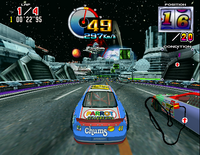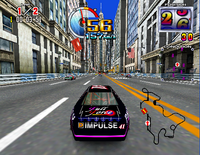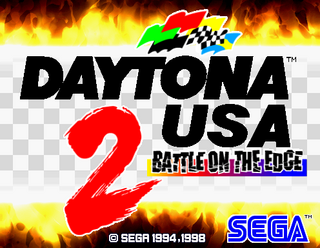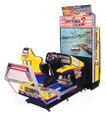Difference between revisions of "Daytona USA 2: Battle on the Edge"
From Sega Retro
m (→Development) |
|||
| Line 22: | Line 22: | ||
==Development== | ==Development== | ||
| − | The ''Daytona USA 2'' development team consisted of roughly half a dozen members from the previous ''Daytona USA'' along with some who had migrated from the ''[[Virtua Fighter 3]]'' team at AM2. The ''Virtua Fighter 3'' developers were said to lack knowledge and experience in developing driving games, but were particularly skilled in animating 3D models. Previous AM2 racing games | + | The ''Daytona USA 2'' development team consisted of roughly half a dozen members from the previous ''Daytona USA'' along with some who had migrated from the ''[[Virtua Fighter 3]]'' team at AM2. The ''Virtua Fighter 3'' developers were said to lack knowledge and experience in developing driving games, but were particularly skilled in animating 3D models. Previous AM2 racing games lacked many humans or animals in-game, however this new skillset allowed ''Daytona USA 2'' to have features such as a much more realistic pit crew (apparently all modelled by just one person, by hand). |
Very little was taken from the original ''Daytona USA'' during development - the game engine was re-built from scratch and the visuals and audio were completely new. The game uses roughly five times as many polygons as the original. | Very little was taken from the original ''Daytona USA'' during development - the game engine was re-built from scratch and the visuals and audio were completely new. The game uses roughly five times as many polygons as the original. | ||
Revision as of 15:28, 3 February 2012
| Daytona USA 2: Battle on the Edge | |||||
|---|---|---|---|---|---|
| System(s): Sega Model 3 Step 2.1 | |||||
| Publisher: Sega | |||||
| Developer: Sega AM2 | |||||
| Genre: Racing | |||||
| Number of players: 1-4 | |||||
|
Daytona USA 2: Battle on the Edge is a sequel to Daytona USA, released exclusively in arcades for Sega Model 3 Step 2.1 hardware in 1998.
Daytona USA 2 builds upon the formula seen in Daytona USA - it is a NASCAR-style racing game where the player drives a stock car across three different circuits, attempting to overtake other players and finish first. It was followed by an update, Daytona USA 2: Power Edition later in the year.
The game is an oddball in the Daytona USA series as it does allow the user to play as the "Hornet" stock car, nor does it include the three levels from the original arcade game. Though the Hornet team is still mentioned through advertisements on the tracks, Daytona USA 2 has the player drive a new set of cars (there are three to choose from, each with their own pros and cons) around three completely new tracks which have not been seen in a Daytona USA game since.
Development
The Daytona USA 2 development team consisted of roughly half a dozen members from the previous Daytona USA along with some who had migrated from the Virtua Fighter 3 team at AM2. The Virtua Fighter 3 developers were said to lack knowledge and experience in developing driving games, but were particularly skilled in animating 3D models. Previous AM2 racing games lacked many humans or animals in-game, however this new skillset allowed Daytona USA 2 to have features such as a much more realistic pit crew (apparently all modelled by just one person, by hand).
Very little was taken from the original Daytona USA during development - the game engine was re-built from scratch and the visuals and audio were completely new. The game uses roughly five times as many polygons as the original.
The cars were modelled on the Chevrolet Monte Carlo, Ford Thunderbird and Pontiac Grand Prix though were tweaked to avoid licensing issues (there are also two types of enemy car which sport generic designs). The performances of the cars were made up - inspired by specalist magazines and books but not taken from the manufacturers themselves. Like the original game, the player's car is given the number "41" - Toshihiro Nagoshi's "lucky number".
Much of the inspiration behind this game came from a team trip to Orlando, Florida, USA. The team travelled to the Daytona International Speedway and used shotgun microphones to record many of the sound effects. The intermediate course is modelled on the likes of Walt Disney World and Universal Studios. The shark at the start of the course is directly inspired by the Jaws ride. The team also travelled to North Carolina for a race around a NASCAR track with a professional driver (where more sound effects were recorded) and to New York, where the expert track would be based on.
Director Makoto Osaki wanted to include an Egyptian-style course however it was said to be too similar to the Mystery Ruins track of Scud Race.
The Model 3 Step 2.1 hardware allowed the developers to utilise effects such as smoke, sparks and fire - a challenge to achieve in previous versions of the hardware.
Takenobu Mitsuyoshi would return to perform the vocals, however Dennis St. James was brought in to do the vocals of the western versions (though they both sing in English). There is an option for arcade operators to switch between the two.
Daytona USA would be followed by Daytona USA 2: Power Edition, which serves as an upgrade to this game. Daytona USA 2: Battle on the Edge would see no home ports of its own, however its advanced and expert tracks would be included as part of OutRun 2 for the Microsoft Xbox. The beginner circuit of Daytona USA 2 is included in that game as well, however it is the Power Edition variant.
Gameplay
From a gameplay perspective, little has changed between Daytona USA and Daytona USA 2, though there is a heavier emphasis on drifting this time around. The visuals and audio however, have been greatly improved to take advantage of the improved hardware.
Daytona USA had the ability for cars to be damaged, but regardless of how many times you were hit the game would still continue (though the car's top speed would decrease). Daytona USA 2 expands on this, cause players to retire if the car is not in a fit driving state. On rare occasions the computer purposely causes two cars in front of the player to crash into each other to add extra challenge, and can in theory wipe every other car off the playfield. Similar to the original AI movements are determined on how the player drives - if he/she is gentle, there is more chance of the AI causing carnage than if the player is seen as "aggressive".
As a whole, the AI has been improved over the original (as opposed to Scud Race which is largely the same), and movement is similar to the player's car (thus stopping erratic behavior sometimes witnessed in previous entries). Like Daytona USA the physics are not precise - there are six crash patterns in Daytona USA 2 which are triggered depending on the speed and angle of impact. Damage, however, is calculated properly, so dents will appear exactly where the car was hit.
Bonnets and doors of enemy cars can be ripped off, however AM2 made sure that this could not happen to the player's car due to a lack of polygons to model the car's interior.
Like the original Daytona USA, cabinets can be linked together, but the game only allows up to four players to compete simultaneously rather than eight. Four players would be the maximum for all the Daytona USA games that followed.
Tracks
 |
The beginner track, Astro Waterfall Speedway as named in the official sound track, takes place within a large bio-dome, but is otherwise a circular track similar to the beginner track in Daytona USA. Like the original game, 40 cars are on the track and the aim is to overtake them all in 8 laps. This level is exclusive to Daytona USA 2: Battle on the Edge - Daytona USA 2: Power Edition removes the dome and turns it into a more standardised NASCAR race track.
The music played on this level is "Sling Shot", and is the only level of the three to have a rolling start. |
 |
The advanced track, Joypolis 2020 Amusement Park, takes place within a theme park (named after the real-life Joypolis parks), making it one of the more peculiar tracks in the Daytona USA series. Cars travel through haunted house, space, lava and ice areas, as well as an outside segment where the track leads under a swinging pirate ship. 20 cars are on the track by default and the race lasts 4 laps.
During laps 3 and 4, if the player taps START the track will light up. The music played here is "I Can Do It". |
 |
The expert track, Virtua City takes place in and around a city reminicant of New York (actually called "New Joke City"). There are only 2 laps by default, but 30 cars.
"Skyscraper Sequence" is the name of the music track used in this level. |
Cheats
Daytona USA 2 has comparitively fewer cheats and secrets than its prequel, however still contains several hidden options.
There are four special "views" to go along with the four advertised. Pressing views 1 and 2 puts the camera behing the front left wheel, while 2 and 3 puts it behind the front right one. Pressing the view 2 button while already in view 2 will switch to a cockpit view. If the user holds the first three view buttons and then presses view 4, the game will switch to a top-down camera, just like in Daytona USA.
If the user holds START while waiting for a race to begin, the music will change. A time attack mode can be activated by holding START and pressing the accelerator at the transmission select screen.
Reverse tracks can be initiated by holding START and pressing the accelerator at the circuit select screen. This change allows the user to see parts of the scenery designed specifically to be seen from the opposite direction.


